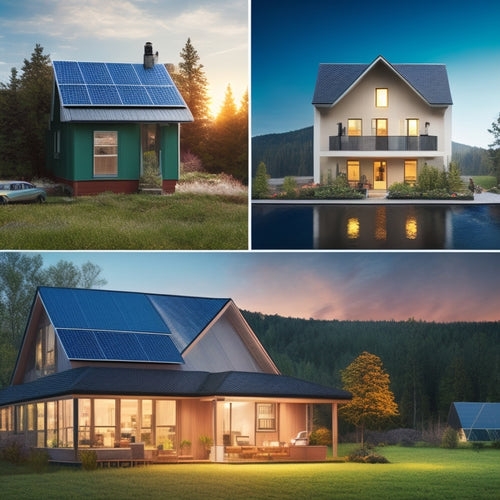
What Are Optimal Blinds for Solar Energy Gains?
Share
You can enhance your home's solar energy gains by selecting the right blinds that balance heat absorption, reflection, and insulation, thereby reducing your reliance on artificial lighting and promoting energy independence. Light-colored blinds with high reflectivity increase solar energy absorption, while dark-colored blinds absorb solar radiation, reducing heat gain in summer. Automated blinds programmed to open during the day and close at night maximize sunlight warming and provide insulation. By choosing the right blinds, you can utilize natural energy, reduce your carbon footprint, and take a step closer to energy independence - and there's more to investigate on this path towards ideal energy efficiency.
Key Takeaways
- Select light-colored blinds with high reflectivity to increase solar energy absorption and optimize energy gains.
- Automated blinds programmed to open during the day and close at night maximize solar energy gains and reduce heat loss.
- Blinds made from high albedo materials, like aluminum, enhance reflection and increase solar energy absorption.
- Effective blind types, such as solar screens and cellular shades, filter sunlight and reduce heat gain, optimizing energy efficiency.
- Orientation and tilt of blinds should be adjusted seasonally to optimize solar energy gains, reducing reliance on artificial lighting.
Maximizing Solar Energy Gains
When it comes to maximizing solar energy gains, you're likely looking to tap into every available watt. To do so, you need to employ effective solar gain strategies.
One vital aspect is selecting the right blind material types. Integrating sustainable practices, such as those found in Renewable Energy Sources for EV Charging, can further enhance energy independence.
Light-colored blinds with high reflectivity can redirect sunlight onto walls and floors, increasing the amount of solar energy absorbed. Conversely, dark-colored blinds can absorb solar radiation, reducing heat gain during summer months.
Consider using blinds made from materials with high albedo, such as aluminum or silver-coated fabrics, to maximize reflection. By choosing the right blind material types, you can optimize solar energy gains and reduce your reliance on artificial lighting, taking a significant step towards energy independence.
Automated Blinds for Winter
During winter months, about 75% of the sun's energy can enter your home through south-facing windows, even on cloudy days. To maximize this free energy, consider installing automated blinds with winter-specific settings. These blinds can be programmed to open during the day, allowing sunlight to warm your home, and close at night, providing winter insulation.
| Time of Day | Automated Blind Setting |
|---|---|
| 9:00 AM - 3:00 PM | Open (allow sunlight to enter) |
| 3:00 PM - 9:00 AM | Closed (retain heat and provide insulation) |
| Overcast days | Closed (minimize heat loss) |
| Extremely cold days | Closed (maximize insulation) |
| Vacant periods | Closed (reduce heat loss when unoccupied) |
Summer Shading Strategies
You'll want to implement summer shading strategies that prioritize shade during peak hours, typically between 11am and 3pm, to minimize heat gain.
During these periods, block direct sunlight from entering your windows to prevent overheating and reduce the need for cooling. By doing so, you'll maintain a comfortable indoor temperature while optimizing your solar energy gains.
Additionally, integrating on-site solar panels can meet up to 100% of your energy needs, promoting energy independence and sustainability.
Shade During Peak Hours
By strategically deploying blinds during summer's peak sun hours, homeowners can take advantage of the benefits of solar energy while mitigating its drawbacks. You can reduce heat gain and energy consumption by implementing peak hour shading strategies.
| Blind Materials | Shading Coefficient |
|---|---|
| Light-Blocking Fabric | 0.3-0.5 |
| Solar Screens | 0.2-0.4 |
| Vinyl or Aluminum | 0.1-0.3 |
Opt for ideal blind materials that provide the right amount of shading coefficient. A lower shading coefficient means more efficient heat rejection. By choosing the right materials and deploying them during peak hours (usually between 11 am and 3 pm), you can enjoy the freedom to stay cool while keeping your energy bills in check.
Block Direct Sunlight
Summer's intense sunlight can wreak havoc on your indoor climate, but a well-executed summer shading strategy can keep the heat at bay.
To block direct sunlight, you'll want to employ light filtering options that reduce glare and heat gain. Properly installed solar panels can increase energy harvesting, so consider solar technology and installation methods that work best for your setup.
Additionally, regular cleaning of solar panels can help maintain their efficiency.
- Overhangs: Design or install overhangs above windows to block direct sunlight during peak hours.
- Solar Screens: Install solar screens on windows to filter out UV rays and reduce heat gain.
- Light-Blocking Curtains: Hang light-blocking curtains or drapes to absorb or reflect sunlight.
- Window Films: Apply window films to reduce glare and heat gain while maintaining your view.
Smart Blinds for South-Facing Windows
South-facing windows receive the most intense sunlight throughout the day, making them ideal for capturing natural energy.
To maximize energy gains, you can install smart blinds that employ advanced smart technology to optimize energy management, similar to how fast charging stations can recharge up to 80% in under 30 minutes.
By integrating with your energy management system, smart blinds can also detect when you're not home and adjust accordingly, ensuring you're not wasting energy.
This freedom from manual adjustments and energy waste allows you to enjoy the benefits of natural energy while minimizing your carbon footprint.
Energy Efficiency in Cold Climates
Efficiency converges with innovation in cold climates, where utilizing solar energy is essential to minimize reliance on non-renewable sources.
As you design your energy-efficient home, you'll want to prioritize solar energy gains while minimizing heat loss. Incorporating Energy-Harvesting and Generating Structures into your design can further enhance energy efficiency. This can be achieved by using energy-harvesting roofs with photovoltaic panels to generate electricity sustainably.
To achieve this, consider the following strategies:
-
Insulating materials: Use high-R-value materials to reduce heat transfer through walls, floors, and ceilings.
-
Thermal mass: Incorporate materials with high thermal mass, such as concrete or brick, to absorb and release heat.
-
Proper window orientation: Orient your windows to maximize winter solar gains and minimize summer heat gain.
- Smart shading devices: Install smart blinds that adjust to optimize solar energy gains and reduce heat loss.
Blinds for East-West Oriented Homes
When you're designing blinds for east-west oriented homes, you'll want to prioritize morning sun control to reduce summer heat gain.
In the afternoon, your focus shifts to reducing heat from the western sun, which can greatly impact your energy consumption.
Morning Sun Control
Across the east-west axis of your home, morning sun control becomes an essential aspect of utilizing ideal solar energy gains. As you seek to maximize natural light and heat, you'll need to balance morning glare and thermal comfort.
To achieve this balance, consider the following strategies:
-
Orient your blinds: Tilt them to redirect morning sunlight, reducing glare and heat gain.
-
Choose the right material: Opt for light-blocking fabrics or solar shades to filter intense morning sunlight.
-
Adjust for seasonal changes: Lower your blinds during winter months to allow more sunlight in, and raise them during summer to reduce heat gain.
- Automate your system: Install motorized blinds that can be programmed to adjust according to the time of day and season, ensuring ideal morning sun control.
Afternoon Heat Reduction
As morning sun control strategies are implemented, your focus shifts to addressing the intense afternoon heat that can compromise your home's energy efficiency. East-west oriented homes receive direct sunlight in the afternoon, making heat management essential for thermal comfort. Effective heat reduction strategies involve combining blind types to filter and block sunlight.
| Blind Type | Afternoon Heat Reduction Strategy |
|---|---|
| Light-blocking blinds | Block direct sunlight, reducing heat gain by up to 75% |
| Solar screens | Filter sunlight, reducing heat gain by up to 90% |
| Cellular shades | Insulate and block sunlight, reducing heat gain by up to 80% |
| Awnings | Block direct sunlight, reducing heat gain by up to 77% |
Winter Daylight Harvest
By orienting your blinds to make use of winter sunlight, you can capitalize on natural daylight and reduce your reliance on artificial lighting. This approach is particularly effective for east-west oriented homes, where morning and afternoon sunlight can be employed to improve daylight exposure.
To enhance winter daylight harvest, consider the following adjustments:
-
Tilt angle: Adjust your blinds to a 45-degree angle to allow winter sunlight to enter your home while minimizing summer sun exposure.
-
Slats: Opt for horizontal slats to control the amount of daylight entering your home, ensuring peak thermal performance.
-
Material: Choose light-colored, reflective materials to maximize daylight reflection and reduce heat gain.
- Automation: Install automated blinds that can adjust to prime angles and positions throughout the day, ensuring seamless integration with your daily routine.
Motorized Blinds for Energy Savings
Motorized blinds can be a groundbreaking innovation for homeowners seeking to maximize solar energy gains while minimizing energy losses. By automating blind adjustments, you can optimize energy efficiency and reduce your carbon footprint. These advanced systems often feature energy efficient materials and seamless smart home integration, allowing you to control your blinds remotely and schedule adjustments according to your preferences.
| Feature | Benefit |
|---|---|
| Scheduled Adjustments | Optimizes energy gains and losses |
| Smart Home Integration | Convenient remote control and automation |
| Energy Efficient Materials | Reduces environmental impact |
| Automated Adjustments | Minimizes manual intervention |
| Customizable Settings | Adapts to your unique energy needs |
Window Orientation and Blind Selection
The ideal orientation of your windows greatly impacts the amount of solar energy your home can harness.
To maximize energy gains, consider the following factors when selecting blinds for your windows:
-
Blind materials: Choose materials with high light diffusion rates to allow natural light in during winter and block it out during summer.
-
Color temperature: Select blinds that filter out high-temperature radiation during summer, reducing cooling costs.
-
Thermal insulation: Opt for blinds with high thermal insulation properties to keep warmth in during winter and out during summer.
- Window film and seasonal adjustments: Apply window film to reduce heat gain during summer, and adjust your blinds seasonally to optimize energy gains.
Optimizing Blind Tilt for Solar Gain
Beyond window orientation and blind selection, optimizing blind tilt is vital for maximizing solar energy gains.
As you consider the best blind materials for your space, remember that tilt angles play an important role in utilizing natural light. During winter months, a higher tilt angle (around 60-70 degrees) allows more sunlight to enter, warming your space.
In summer, a lower tilt angle (around 20-30 degrees) reduces direct sunlight, keeping your space cooler.
By adjusting your blind tilt, you can optimize solar energy gains, reducing your reliance on artificial lighting and heating.
Experiment with different tilt angles to find the perfect balance for your unique space and climate.
Frequently Asked Questions
Can I Use Solar-Powered Blinds to Reduce Energy Costs?
You can utilize solar power to reduce energy costs by installing solar-powered blinds, which optimize solar savings and energy efficiency, giving you freedom from high bills and a clear conscience.
Do Smart Blinds Work With Existing Window Treatments?
Will you really be limited by your existing window treatments? Fortunately, many smart blinds integrate seamlessly with your current setup, offering smart home integration and window treatment compatibility that works with you, not against you.
Are There Blinds Suitable for Windows With Odd Shapes?
You'll find blinds that fit your uniquely shaped windows with custom window treatments offering unique blind designs, ensuring a perfect fit and ideal functionality, giving you the freedom to control light and heat as you desire.
Can I Install Automated Blinds on Old Windows?
Break free from outdated limitations! You can, in fact, install automated blinds on your old windows, but it's essential to confirm compatibility with your window frames and consider professional automated installation to assure seamless integration.
Are There Energy-Efficient Blinds for Skylights Available?
You'll find energy-efficient blinds for skylights that enhance thermal performance, using materials like fiberglass, cellular shades, or honeycomb shades, which reduce heat loss and gain, giving you freedom to control your indoor climate.
Related Posts
-

What Does Your Home Energy Audit Report Reveal?
Your home energy audit report reveals a detailed analysis of your energy consumption patterns, highlighting areas of ...
-

What Do Power Strips Do for Standby Energy?
You're likely aware that your devices, such as TVs and computers, continue to draw power even when turned off, a phen...
-

10 Powerful Electric Mowers for Expansive Lawns
You're moving away from gas-powered mowers and exploring electric options for your expansive lawn. You'll find that h...


